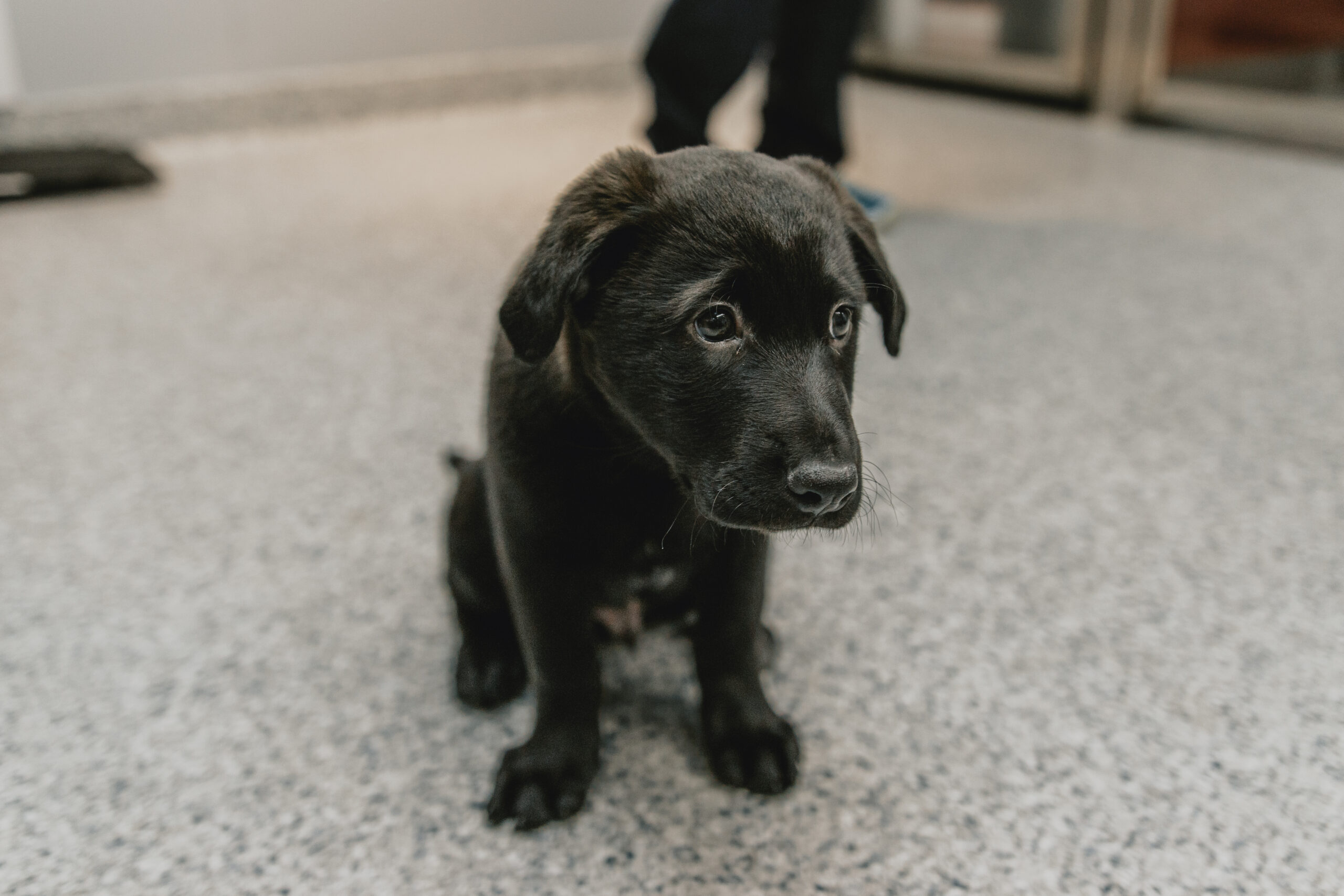The Puppy Code : Mastering the Journey of Puppy Parenting
by Ontario SPCA and Humane Society | Dog Care | May 6, 2025

Guest blog by Dr Emmanuel Fontaine, Scientific Communications Veterinarian at Royal Canin North America
Every dog parent dreams of sharing a unique, unbreakable bond with their furry companion. But nurturing that special connection begins the moment you bring your puppy home. By starting on the right foot, you lay the foundation for a lifetime of love, trust, and companionship. To achieve this harmonious partnership, we must dive into three essential rules for cultivating a healthy relationship with your puppy. Each rule will provide invaluable insights into the world of puppy parenting, guiding you to create a nurturing environment where your puppy can thrive. With these rules, you’ll be on your way to an unforgettable, rewarding journey with your new best friend.
Rule 1: Puppy Leadership – Consistency is key!
Imagine your puppy as a blank canvas, eager to absorb guidance and develop its unique personality. It is essential to shape their behaviour and instill lifelong habits. By providing clear, consistent guidance, you become your puppy’s loving and trusted leader. This role is crucial in fostering a balanced, well-mannered dog.
Puppies need discipline and guidance in their formative months to grow into well-adjusted adult dogs. Without structure and clear expectations, your puppy might develop undesirable habits that will be difficult to break later on. Consistency is key in setting the right expectations and guiding your puppy’s behaviour. This means you should always enforce the same rules and respond similarly to both desirable and undesirable actions. Inconsistent responses may confuse your puppy, making it harder for them to learn what is expected of them.
To effectively discipline your puppy, use a firm and concise tone when addressing undesirable behaviour. A simple yet assertive “NO” can work wonders in conveying your disapproval. However, it is equally important to balance discipline with positive reinforcement. When your puppy exhibits good behaviour, reward them with praise, affection, or treats. This encourages them to repeat the desirable actions in the future.
Redirecting your puppy’s attention is another useful tool when disciplining them. For example, if your puppy is chewing on your shoes, redirect their focus towards an appropriate toy. This not only teaches them what is off-limits but also provides a suitable alternative for their natural chewing instincts.
Incorporating these strategies into your daily interactions with your puppy will help establish your authority and maintain a disciplined environment. As your puppy learns to respect your leadership, the foundation of trust and understanding will grow, leading to a harmonious relationship and a well-behaved dog that is a joy to be around. Remember, your puppy looks to you for guidance and assurance, so rise to the challenge and be the leader they need.
Rule 2: Guiding Paws – The Blueprint for Harmony
As your puppy grows, they will naturally test boundaries to understand their environment and your expectations. Setting boundaries for your puppy is pivotal in guiding their development and maintaining a harmonious household. Establishing clear boundaries early on allows your puppy to adapt and understand the rules that govern their life, leading to a more balanced and well-behaved companion.
To establish these boundaries, first decide on the specific rules you want to enforce in your household. Will your puppy be allowed on furniture? Are there rooms that are off-limits? Establishing these rules early on is crucial to avoid confusion and ensure a smooth transition for your puppy.
Once you’ve determined your household rules, communicate them effectively to your puppy. This may involve consistent verbal cues, body language, or even physical barriers like baby gates. Remember, consistency is key. If you allow your puppy to bend the rules even once, they may assume it’s acceptable and continue the behaviour.
For example, if you’ve decided that your puppy is not allowed on the bed or sofa, enforce this rule from day one. If you let your puppy climb onto the furniture occasionally, they will struggle to understand why it’s not allowed at other times. Similarly, teach your puppy which items are designated for play and which are off-limits. Providing a variety of appropriate toys will satisfy their curiosity and discourage them from seeking out your personal belongings.
Failure to establish boundaries early on can result in undesirable behaviours becoming ingrained habits, making them difficult to correct later. By investing time and effort in setting these boundaries, you are creating a secure environment where your puppy can flourish.
Rule 3: Bowl Basics – Cultivating Healthy Feeding Habits
The intricate elements of your puppy’s health are interconnected, and proper nutrition is central to overall wellbeing. Ensuring your puppy receives the right nutrients will not only foster physical growth but also influence their overall well-being and behaviour.
The table is not a place for your puppy, and neither is a diet of human leftovers. This practice may feel like an expression of love or a way to reduce waste, but it can invite a slew of problems. Feeding your puppy scraps can lead to unhealthy weight gain and potentially serious digestive issues due to the richness and variability of human food. Moreover, it can also foster begging behaviour, turning your mealtimes into a battle of wills.
To establish healthy feeding habits, start by setting a regular feeding schedule. Puppies thrive on routine, and knowing when to expect their meals can alleviate anxiety and prevent overeating. Opt for puppy-specific foods that are balanced to support their rapid growth and development. As your puppy grows, their dietary needs will change, so it’s essential to keep up to date with the best options for their age, size, and breed.
Mealtimes also offer an excellent opportunity to reinforce good behaviour. Encourage your puppy to sit calmly and wait for their food, discouraging any rushing or jumping. This can teach them patience and respect, valuable traits that extend beyond feeding times.
A well-fed puppy is a happy puppy, and by establishing healthy feeding habits, you’re setting the stage for a lifetime of good health and vitality. Remember, good nutrition is not just about what you feed your puppy, but also how and when you feed them. By adhering to these guidelines, you can ensure your puppy gets the nutrition they need while also promoting good behaviour and a harmonious home environment.
The Puppy Connection – Building a Lasting Friendship
As you navigate the journey of puppy parenthood, one destination should always be in sight – building a strong bond with your furry friend.
A healthy relationship with your puppy brings numerous benefits. It enhances communication, improves your puppy’s behaviour, and provides emotional support for both of you. As your puppy grows, your bond will deepen, turning your pet into a beloved family member, confidante, and a lifelong friend.
Fostering this bond requires time, patience, and understanding. Regular playtime and exercise are vital for your puppy’s physical health and provide an excellent opportunity for bonding. Whether it’s a game of fetch in the park, a walk around the neighborhood, or a fun training session, these shared experiences create a language of love and trust between you and your puppy.
Providing mental stimulation is equally important. Engaging your puppy in interactive games, teaching them new tricks, or providing puzzle toys can keep their minds sharp and enhance their cognitive development. These activities also reinforce your role as their trusted leader, strengthening your bond further.
Socialization, too, is a critical aspect of your puppy’s development. Exposing them to different people, dogs, and environments will help them become confident, well-rounded dogs. Through these experiences, your puppy will learn to trust your guidance and look to you for reassurance in new situations.
Remember, your relationship with your puppy is a two-way street. As much as they look to you for love and guidance, they also offer unconditional love, companionship, and countless moments of joy. So, invest in this relationship, follow the three rules, and watch as your bond with your puppy blossoms into a beautiful tree of companionship.
As the sun sets on our exploration of these essential rules, let’s pause to reflect on the journey we’ve embarked on. We’ve delved into the intricacies of establishing authority, setting boundaries, and fostering healthy feeding habits. In the grand scheme of things, these rules are the stepping stones leading to an incredible destination – a rewarding, loving relationship with your puppy. They’re the keys that unlock a world of understanding between you and your furry friend, paving the way for a harmonious coexistence. This journey isn’t without its challenges. There will be days of frustration, confusion, and maybe even a little chaos. But remember, every step, every stumble is a learning opportunity, a chance to grow, to understand, and to connect with your puppy on a deeper level. So, embrace these rules, cherish the journey, and let the love you share with your puppy guide you. The result will be a bond that transcends the ordinary, a companionship filled with love, respect, and mutual understanding. A relationship that, in its own unique way, will undoubtedly be “pawsome”.

Emmanuel Fontaine graduated from the Toulouse Veterinary School in 2004, he continued his studies at the Alfort Veterinary School (Paris) as trainee Vet in the domestic carnivore unit of the Reproduction Department. From 2005 to 2011, he worked at the Centre d’Etude en Reproduction des Carnivores (CERCA) [Research Centre for Reproduction in Carnivores], a unit specializing in pet breeding assistance. Emmanuel Fontaine is also qualified at the European College for Animal Reproduction (ECAR) and completed his PhD in 2012 on the use of GnRH agonists in canines. From September 2011 to September 2018, he worked as Technical Services Veterinarian for the PRO team at Royal Canada. He then was in charge of Scientific Communication for the Americas until August 2022. He now works as Senior Scientific Communications Veterinarian for Royal Canin North America.
Categories
Testimonial
Thank you so much for all you do
Thank you so much for all you do every day to rescue animals in need. I can’t imagine the terrible situations that you see every day. It is great that you have the heart to help. Keep up the good work.
